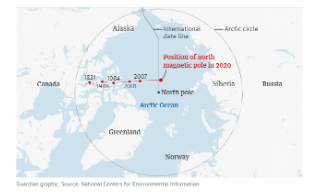Published on Mar 12, 2019
RSTV Video
RSTV IAS UPSC – Shifting Magnetic North Pole
Shifting Magnetic North Pole
TOPIC: General Studies 1In News: Recently, it was observed that the Earth’s north magnetic pole had been exhibiting strange behavior and quickly moving away from Canada, even crossing the International Date Line last year. As of now, this pole has been redefined by the World Magnetic Model because of its rapid movement. This extreme wandering has caused increasing concerns over navigation, especially at high latitudes. Earth’s Magnetic Field Earth's magnetic field surrounds and protects our planet from the hottest, most statically charged particles that the sun can throw our way. This shield -- the natural product of molten iron swirling around the planet's core – has had our backs for billions of years and has prevented Earth from becoming an irradiated, electrified wasteland. The World Magnetic Model records those changes. The model is a joint product of the British Geological Survey and the United States National Oceanic and Atmospheric Administration. The two agencies were planning to report changes in the magnetic north pole, as they do every five years, at the end of 2019. But the pole has moved so quickly they had to release the information much sooner. Scientists have found that the magnetic north pole is moving at a speed of about 55 kilometres every year. One hundred years ago, the pole was located near the coast of northern Canada. It crossed the International Date Line, the imaginary line running through the Pacific Ocean from the North Pole to the South Pole, in 2017. Now, the magnetic north pole is in the middle of the Arctic Ocean and moving towards Russia.
- Important Geophysical phenomena such as earthquakes, Tsunami, Volcanic activity, cyclone etc., geographical features and their location
- Changes in critical geographical features (including water-bodies and ice-caps) and in flora and fauna and the effects of such changes.
 Why could this phenomenon be occurring?
Researchers have suggested that it may be because of the deeply embedded hydromagnetic waves, the movement of liquid iron in the Earth’s core, climate change, or a combination of all these factors.
The Earth's physical structure is behind all this magnetic shifting. The planet's inner core is made of solid iron. But the reason is turbulence in Earth's liquid outer core. There is a hot liquid ocean of iron and nickel in the planet's core where the motion generates an electric field.
The Earth itself spins on its axis. The inner core spins as well, and it spins at a different rate than the outer core. This creates a dynamo effect, or convections and currents within the core. This is what creates the Earth's magnetic field -- it's like a giant electromagnet.
Exactly how the dynamo effect changes the field isn't widely understood. Shifts in the core's rate of spin and the currents within the molten material most likely affect the planet's field and the location of the poles. In other words, the poles move because the convection in the core changes. These changes might also cause the poles to switch places. Irregularities where the core and mantle meet and changes to the Earth's crust, like large earthquakes, can also change the magnetic field.
Uses of World Magnetic Model
Why could this phenomenon be occurring?
Researchers have suggested that it may be because of the deeply embedded hydromagnetic waves, the movement of liquid iron in the Earth’s core, climate change, or a combination of all these factors.
The Earth's physical structure is behind all this magnetic shifting. The planet's inner core is made of solid iron. But the reason is turbulence in Earth's liquid outer core. There is a hot liquid ocean of iron and nickel in the planet's core where the motion generates an electric field.
The Earth itself spins on its axis. The inner core spins as well, and it spins at a different rate than the outer core. This creates a dynamo effect, or convections and currents within the core. This is what creates the Earth's magnetic field -- it's like a giant electromagnet.
Exactly how the dynamo effect changes the field isn't widely understood. Shifts in the core's rate of spin and the currents within the molten material most likely affect the planet's field and the location of the poles. In other words, the poles move because the convection in the core changes. These changes might also cause the poles to switch places. Irregularities where the core and mantle meet and changes to the Earth's crust, like large earthquakes, can also change the magnetic field.
Uses of World Magnetic Model
- The military uses the WMM for undersea and aircraft navigation, parachute deployment, and more.
- Other governmental organizations, such as NASA, the Federal Aviation Administration, US Forest Service use this technology for surveying and mapping, satellite/antenna tracking, and air traffic management.
- The constant shift is a problem for compasses in smartphones and some consumer electronics.
- Airplanes and boats also rely on magnetic north, usually as backup navigation.
- GPS isn't affected because it's satellite-based. But airplanes and boats do depend on magnetic north in emergencies.
- Airport runway names are based on their direction toward magnetic north and their names change when the poles move. For example, the airport in Fairbanks, Alaska, renamed a runway 1L-19R to 2L-20R in 2009.
- Migratory animals that use the Earth's magnetic field would find it difficult to orient themselves.
- What do you understand by the term ‘geomagnetism’? What causes the earth to behave as a magnet? Has earth’s magnetic field changed in it’s geological past? Discuss its implications.
- What is aurora australis? How does it occur? Also examine its effects.
